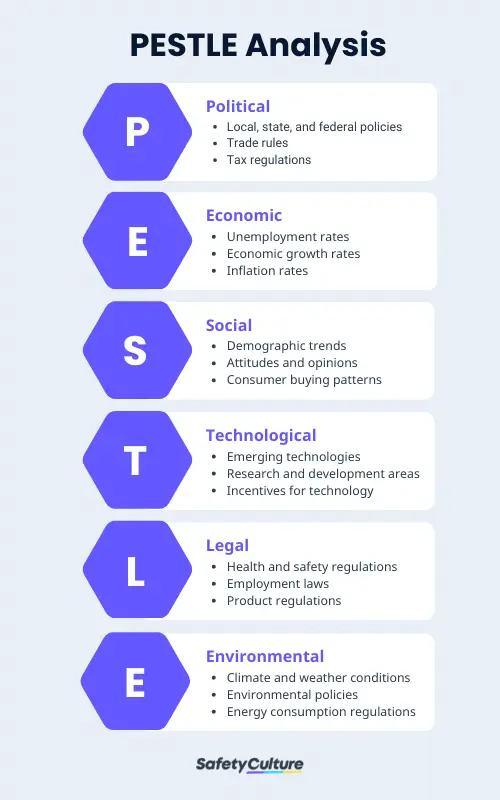What is PESTLE Analysis?
The PESTLE analysis, also known as the PEST or PESTEL analysis, is a marketing framework utilized in enterprise risk management and strategic planning procedures. It is an acronym for Political, Economic, Social, Technical, Legal, and Environmental. The PESTEL model is also a popular tool among management consultants to assist their customers in developing innovative products and market initiatives, as well as in the financial analyst community, where factors such as cost of capital may impact model assumptions and financing choices.
The PESTEL model has been modified in specific ways, as marketing experts have added elements like an E for Ethics to promote the demographic aspect while performing market research.
Understanding PESTLE Analysis

PESTLE Analysis
PESTLE provides a bird’s-eye view of the whole environment from many different perspectives, allowing you to examine and manage it while considering a particular concept or plan. Below are the in-depth explanations of each component of the PESTLE framework:
Political Factors
These elements influence a government’s impact on the economy or a specific sector. A government policy may, for example, impose a new tax or duty that causes organizations’ revenue generation methods to alter.
Tax policies, fiscal policy, trade barriers, and so on are all political factors that a government may impose throughout the fiscal year, which can significantly influence the company environment (economy).
Economic Factors
These factors are important indicators of an economy’s performance that have immediate and long-term repercussions. For example, a rise in any country’s inflation rate would influence how firms charge for their goods and services. It would also impact a consumer’s purchasing power and alter demand and supply models for that economy.
The inflation rate, interest rates, foreign currency exchange rates, economic growth patterns, and other factors are considered economic variables. It also includes foreign direct investment (FDI) depending on the investigated sectors.
Social Factors
Various parameters study the market’s social setting and assess factors such as cultural trends, demographics, population statistics, etc. Buying patterns in Western nations like the United States, where there is a lot of demand during the holiday season, are an example of this.
Technological Factors
It’s an important time for anybody involved in the industry and market to understand the changes occurring. Automation, research, and development, as well as a market’s level of technological awareness, are all examples of these factors.
Legal Factors
Internal and external factors of the business environment are all taken into account. For example, a nation’s business environment may be affected by certain legislation, but businesses maintain specific corporate policies for themselves.
These variables are both taken into account when conducting a legal analysis, which maps out the methods in light of these regulations. Consumer rights, workplace safety rules, and labor laws are a few examples of legal factors in PESTLE analysis.
Environmental Factors
Taking environmental influences into account is essential. For example, specific sectors, such as tourism, farming, and agriculture, require special attention in this area of the PESTLE.
Climate, weather, geographical location, global climate change impacts, and environmental offsets are all examples of business environmental analysis factors.
What is it Used For?
A PESTLE analysis may uncover and interpret broad, long-term trends by auditing the external environment. It can aid a variety of business planning situations, including:
Strategic Business Planning
A PESTLE analysis provides context about the company’s trajectory, brand positioning, growth objectives, and productivity risks (such as a pandemic). It can assist in evaluating existing goods and services and defining new product development.
Workforce Planning
PESTLE analysis can reveal problematic changes in business models that may negatively affect employment opportunities in the future. It can spot skill shortages, new job roles, wage reductions, and displacements.
Marketing Planning
PESTLE analysis determines the ‘environment’ component of situation analysis in marketing planning. It may help managers prioritize company activities and achieve specific marketing goals within a time limit, allowing them to devote more time to completing more important tasks.
Product Development
PESTLE analysis can help you determine if a product or service still fulfills a need in the marketplace, whether to enter or exit a route to market and when to launch a new product by monitoring external activity.
Organizational Change
The PESTLE analysis aids in comprehending the environment for change, and it’s most beneficial when used together with a SWOT analysis to identify possibilities and concerns surrounding labor modifications, such as skill shortages or present workforce capabilities.
Planning the Organization’s Future
Using a PESTLE analysis, you can predict what will happen in the future and find out what needs further research. This method aligns people’s plans with the organization’s overall plan without overlooking or ignoring certain fundamentals.
Create Your Own PESTLE Framework Template
Eliminate manual tasks and streamline your operations.
Get started for FREEHow to Do PESTLE Analysis?
Businesses may utilize one of the several PESTLE analysis templates available when performing an evaluation.
Consider how future developments might influence your present position while analyzing the PESTLE template against the current situation. Some industries may place a higher value on one or more sections. For example, while there may be many similarities in their goals, the priorities of organizations involved in tourism will be considerably different than those of the health, information technology, mining, banking, and military sectors.
The following are four things you may do while performing a PESTLE analysis.
Brainstorm
Gather ideas based on the six PESTLE factors. You can brainstorm as a group or form smaller groups and combine the ideas.
Online collaboration tools help people work together better than traditional brainstorming tools. They reduce the time and effort needed to combine independent lists and make organizing and prioritizing information much quicker and easier.
Group
Group similar ideas and eliminate duplicates after you’ve gathered all of your teammates’ suggestions.
This phase is more time-consuming if the brainstorming is done one at a time or dispersed across many locations and time zones. Online collaboration tools that allow people to share ideas may significantly ease this stage, resulting in a superior result.
Rate
Evaluate each concept based on how significant you believe it will be to your company’s success.
It is essential to discuss any significant differences in the ratings. Invite people to explain their thinking and, if possible, have them re-rate the concept based on discussions. The more aligned everyone’s ideas are with each component, the better informed they will be regarding problems affecting other parts of the firm, and the more focused your strategic planning will be.
Share
The final template can present a clear picture of the company’s condition. Once it’s complete, distribute the PESTLE analysis results to stakeholders. The report may be used to track development and as a basis for future evaluations.
Repeat the PESTLE analysis regularly to keep up with macro environment changes and maintain your current strategies and plans.
The framework works best when you get input from various viewpoints. It’s tough to bring everyone together simultaneously in big or scattered teams. Video conferencing, online documents, and collaborative brainstorming tools can help with many issues.
Tips When Performing PESTLE Analysis
Here are some helpful PESTLE analysis suggestions:
- Collaborate to get a deeper view of the situation and find new risks.
- Examine the firm’s expertise and resources.
- Use PESTLE analysis and other methods such as SWOT analysis, Ansoff’s Matrix, Porter’s Five Forces, competitive study, or scenario planning.
- Include a PESTLE evaluation into an ongoing process for monitoring changes in the business environment.
- It’s a waste of time to collect a lot of data and then analyze it without knowing what you’re looking for.
- Make no assumptions about the future based on the present or past.
FAQs about PESTLE Analysis
You can perform a PESTLE analysis at any time to evaluate where you are and what you’re likely to experience in the future. This exercise benefits marketing, organizational change, business, and product development, and research planning.
PESTLE analysis has several advantages, but it also has some drawbacks. Here are some of them:
- The environment is constantly changing – what was relevant six months ago may not be now. Due to the constant changes, it is challenging to keep up, so the information in your PESTLE analysis may quickly become outdated.
- Much speculation is required – since the future is impossible to predict with 100% accuracy, you will have to make several assumptions when performing a PESTLE analysis. It can lead to inaccurate results.
- Data overload – Because PEST analysis necessitates gathering such large amounts of data, sifting through it and deciding how to utilize it to your advantage is time-consuming.
- Risk of inaccuracy – You can’t be sure that the information you’re receiving is correct because, most of the time, you’ll be obtaining it from outside sources.




